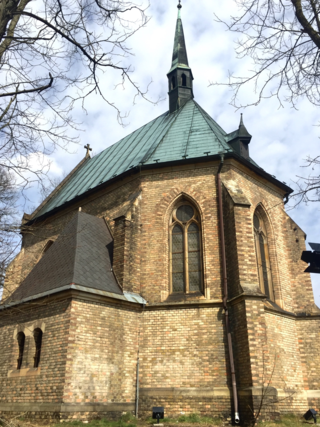
The Basilica of St. Peter and St. Paul is a neo-Gothic collegiate and parish church in Vyšehrad fortress in Prague, Czech Republic.

Master M. S. was a 16th-century painter in Central Europe in late Gothic and early Renaissance art.

The Franciscan Church is the oldest existing religious (sacral) building in the Old Town of Bratislava, the capital of Slovakia. The church was consecrated in the year 1297 in the presence of King Andrew III of Hungary. In the past, the church building served for larger gatherings of townspeople or Hungarian nobles. In 1526 Ferdinand I, Holy Roman Emperor was elected here to become the King of Hungary. During coronations, kings used to knight nobles as Knights of the Order of the Golden Spur in this church.

The Church of the Mother of God before Týn, or Church of Our Lady before Týn, is a Gothic church and a dominant feature of the Old Town of Prague, Czech Republic. It has been the main church of this part of the city since the 14th century. The church's two towers are 80 m high, and each tower's spire is topped by eight smaller spires in two layers of four.

Troyes Cathedral is a Catholic church, dedicated to Saint Peter and Saint Paul, located in the town of Troyes in Champagne, France. It is the episcopal seat of the Bishop of Troyes. The cathedral, in the Gothic architectural style, has been a listed monument historique since 1862.

The Cathedral of St. Bartholomew, originally the Church of St. Bartholomew, is a Gothic church located on the Main Square in Plzeň, Czech Republic. It was probably established together with the city around the year 1295. The church became a cathedral in 1993, when the Plzeň diocese was created. It was designated a national cultural monument of the Czech Republic in 1995.

Spišský Hrušov is a village and municipality in the Spišská Nová Ves District in the Košice Region of central-eastern Slovakia. In 2011 had 1,266 inhabitants

The Church of St. Elizabeth, commonly known as Blue Church, is a Hungarian-Secessionist Catholic church located in the eastern part of the Old Town in Bratislava, present-day Slovakia. It is consecrated to Elisabeth of Hungary, daughter of Andrew II, who grew up in the Pressburg Castle (Pozsonyi vár). It is referred to as "The Little Blue Church" because of the colour of its façade, mosaics, majolicas and blue-glazed roof. It was initially part of the neighboring gymnázium and served as the school chapel.

The town hall in Banská Štiavnica existed in the 14th century, as a ground floor house in Gothic style, with the name "Stuba Praetoriana" or "Stuba Judicis". Between 1507 and 1679 it was modified and extended in Renaissance style. The Chapel of St. Anna was attached to the building but was demolished in the 18th century and, in its place, a sculpture of the Virgin Mary was built.
The Church of Saint Catherine of Alexandria is located in Slovakia, in the village Topoľčianky. Location of Topoľčianky is middle west Slovakia. It is 30 km away from the city of Nitra.

Saint Nicolas Church or Basilica of Saint Nicholas is a Gothic/Baroque church in Trnava, Slovakia. In 2009 Pope Benedict XVI granted the parish church of St. Nicolas the honourable title of minor basilica.

St Martin's Cathedral is a cathedral in Slovakia. It is located in the town of Spišská Kapitula and is the cathedral church of the Spiš diocese.

The Co-Cathedral of Saint Nicholas in Prešov is one of the oldest and most important churches in Slovakia. The external dimensions of the cathedral are 54.7m in length and 34.45m in width. The indoor nave is 16 m tall and the tower reaches a height of 71 meters. The temple's design takes inspiration from the Late Gothic hall churches with three naves.

Church of Saint Margaret of Antioch, near Kopčany, Slovakia, is one of still standing churches for which the Greater Moravian origin is considered. It belongs to the oldest churches in Slovakia. The church was built probably in the 9th or 10th century and was first mentioned in 1329. It was used until the 18th century when a new church was built in the village of Kopčany.

Basilica of St Giles in Bardejov, Slovakia, is a Gothic sacral building, which is situated in the northern part of the Town-Hall square. Bardejov is located in the larger area of town Prešov in the region called Šariš.

The Basilica minor of the Exaltation of the Holy Cross is a Late Gothic three-nave Catholic church located in the town of Kežmarok in the Spiš region of eastern Slovakia.

St. Castulus church is a Gothic church with Romanesque and Baroque elements. It is located on the Castulus square, in Old town near Convent of Saint Agnes. It is the only church in the Czech Republic consecrated to Saint Castulus.

The Church of the Assumption of the Virgin Mary and St. Charles the Great is located in the Karlov area of Prague. The originally Gothic church was rebuilt and augmented in baroque style. The church is a part of the former convent of the Augustinian Order in Prague's Karlov.

Chapel of Our Lady of Sorrows is a chapel in Beroun in the Central Bohemian Region of the Czech Republic. It is located on one of the highest points of the town. On 3 May 1958 the chapel was officially listed as a cultural heritage site.

The St. Mary's Church, or formally, Church of the Assumption of the Blessed Virgin Mary in Gryfice, is a parish church, one of the religious buildings in the city, built from the turn of the 13th and 14th centuries to the end of the 15th century.





























